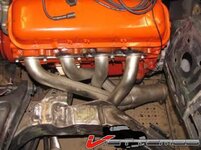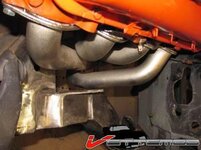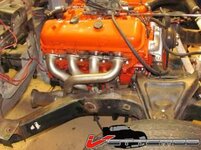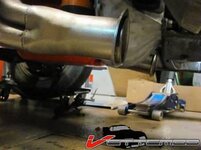Just watched your start up videos, nice! Did you do some kind of priming of the fuel system/carb before start? Filled the carb or?
I´m just about ready to fire up my engine and starting to get nervous about everything that can go wrong...
Best regards, Daniel
I just filled carb bowl with gas.
I wouldnt be too nervous the way you prepared LOL
Just make sure you have as much water you can in the rad and block.
Heres a copy of a pretty good check points procedures on first start.
This was on chevelle.com
http://www.chevelles.com/forums/showthread.php?t=72040
Post number 10
Whether you've rebuilt your engine yourself, had it rebuilt or have a brand new engine, you have alot of money invested
at this point. Now your ready for that last big task...Starting it! I can remember the day I started my engine for the first
time. I know that I will never forget it. It's a very tense feeling especially if it's your first time. It's about as nerve racking as
waiting in the fathers waiting room for your first born!
This article will focus on the proper method of starting up a new or rebuilt engine for the first time and to help alleviate
some of those nervous feelings. Following the information found here, you can correctly break in your new engine. This
information comes from various books but mostly from my own personal experiences.
Starting an engine for the first time is a make or break deal for the camshaft. (unless your using a roller cam-these do
not require the usual break the way the flat tappet type do) If done correctly, your engine will provide years of service. If
done incorrectly, you can do major damage within minutes! It's the first 5 minutes of running time that can wipe out a new
cam. The other 15 minutes is just insurance. If I haven't scared you away yet, continue on as I list all the do's and dont's
to help you avoid such a disaster.
A very important step is preperation. This isn't something to rush into. Taking a day or two before fire-up to look over
the engine and double check (even triple check) your work is a good idea. Sometimes it's easy to over look the most
common of things. You want to find any loose bolts, loose fittings, etc now rather than on the "big day." You did remember
to remove that shop rag from the intake before bolting on the carb didn't you???
Here is a list of items to adjust and check a day or two prior to fire-up:
Valve adjustment-This is very important to do now. Spend as much time as needed until your sure all the valves
are adjusted to specs.
Ignition timing-Another important step. If the timing isn't set correctly, your engine may run poorly or not start at all.
You want the engine to start right away and avoid any unnecasary cranking which can damage the cam lobes.
Check over the torque of the headbolts, intake bolts, exhaust manifold or headers as well as all external engine
parts such as fuel pump, water pump, etc.
Pre-fill the carb with fuel and make sure the accelerator pump is working. It should spray gas out in steady streams.
Doing this will insure that your engine gets fuel immediately. No fuel...no start.
Fill oil filter with oil-If you haven't already, it's very important to do this with your new engine to insure that the
engine has a continuous supply of oil and doesn't hit a dry spot. (it's a good idea to do this everytime you do an oil
change too)
Be sure to use a thermostat. You want the engine to reach normal operating temperature. Not using a 'stat can
cause the engine to run too cold and not heat up properly. It's also a good idea to test the 'stat ahead of time even
if it's new. Place 'stat in a pot of boiling water on the stove to be sure it will open. To avoid any air pockets which
would cause overheating, with thermostat removed, fill the block with distilled water then re-install the stat. Then
simply fill the rest of the cooling system at the radiator as normal. It's important to use water at this point and not
antifreeze. If your new engine should have an internal leak, antifreeze getting to the bearings could wipe them out.
Check over spark plug wire routing. Be sure all wires are installed to the correct cylinders and that they are not
touching any part of the engine that will burn them.
Install an oil pressure gauge and temperature gauge to the engine even if you don't plan on keeping them in the
car. It's best to monitor the engines vital signs with gauges than to rely on idiot lights.
Install a tachometer. You'll need one to monitor the rpms during break in.
Now go get some sleep. Tomorrow is a big day!
Heres the list of things to do on fire up day:
Having a helper is a plus. An extra set of eyes never hurts! If no helper is available, don't fear. This job can be
done by one person. Im living proof of that.
Check all fluids, belts, and visually go over all bolts fittings and connections one last time. I know, you just did this
yesterday but do it again anyway! Remove radiator cap and leave it off until the thermostat opens. This will ensure
that any trapped air in the system will be able to escape. (once the thermostat opens you can install the cap and
continue on with the break in) Install battery and check power wire at the coil. (without power here, engine will not
start)
Pre-prime the oiling system. This is very important! Remove distributor and all spark plugs. Attach an old distributor
shaft with the housing (cam gear must be removed) or a store bought primer to an electric drill and spin in a
clockwise direction for a few minutes. Check oil pressure gauge to be sure all is working good. Turn engine over a
1/4 of a turn, and spin oil pump again for a minute or two. Continue this until the engine has gone 2 full revolutions
then, reinstall the distributor being sure to a align the rotor so it points to #1. (the number 1 cylinder of the engine
must be on the compression stroke-if it's not, the engine won't be in time and will not start) It's also a good idea to
remove the valve covers during priming to be sure that oil is reaching the top of the engine. *note-if using only a
store bought primer rod with no distributor body the oil will not make it this high up into the engine as it's the
distributor body that directs the oil up into this area.
Place a house fan directly in front of the radiator to blow cool air into it. An engine running at a high rpm standing
still will benefit from the extra air.
Have a garden hose nearby in the event of a fire. A fire extinquisher is also a good idea but use that as a last
resort as it will really make a mess! (saving your car is the most important thing however)
Have a watch or clock available.
Dump about a 1/4 cup of gas down the carburetor and operate the throttle to allow the fuel to pass through the
throttle plates. Look down carb while moving the throttle to check one more time that the accelerator pump is
working. (the engine is bone dry at this point so it will need a bit more fuel than usual but don't go overboard)
Check to make sure choke is working properly and that it's set where it will start your cold engine. Install the air
cleaner. (be sure to use the air cleaner in the event of a backfire-if any flames do backfire through while trying to
start, crank the engine again to suck them back into the engine-this is a good tip to remember anytime this
happens)
You'll need a way of keeping the engine at 2,000 rpm's for the break-in. If you have a helper, one of you can sit in
the car and do this via the gas pedal. If your going solo on this one, do what I did. Tie a piece of heavy string to the
throttle linkage at the carb. Make it long enough so you can reach it while standing at the driver door. After engine
starts and you have the rpm's at 2,000, just tie the string off near the cowl or hood hinge. Then you will be free to
walk around and keep an eye on everything.
Do the break-in outdoors! There will be alot of smoke coming off of the exhaust manifolds or headers especially if
you have coated them. There will be plenty of blue smoke coming out of the tail pipes as well until the rings seat
themselves. Do not be alarmed when you see this, it's normal. Be sure to have adequate ventilation. * Note-Moly
faced rings will be broken in by the time you get the cam broken in. If using any chrome face type rings, take the
car out on an open stretch of road and starting at 30 mph, accelerate to the legal speed limit. When you get to the
limit, let off on the gas and let the engine pull the speed down to 30 mph. Repeat this about 10 times and your
rings should be seated properly. This procedure can also be done if using Moly rings as an added insurance.
With all that done, your ready to bring that beast to life! Are you nervous??? If you said no, your a liar! Now take a deep
breath. When you are sure that your ready and you feel confident that nothing has been over looked, pump the pedal a
few times and hit the key. If everything has been done properly, the engine should roar to life almost immediately. If it
doesn't start within a reasonable amount of time (say 10-15 seconds), stop and find out why. Do not continue cranking.
Once the engine starts, hold the throttle at 2,000 rpm's. Hydraulic lifters will be noisy for the first minute or two until they
pump up. Check oil pressure gauge to be sure there is sufficient pressure. Listen to the engine for any odd sounds.
Check engine at this point for any fuel leaks and if all is well, you can tie off the string to hold the throttle at 2,000 rpm's.
Note the time. Keep the engine running at this speed for 20 minutes. (if there are any problems, you'll have to shut down
immediately. Allow rpm's to drop down quickly and turn key off right away. Do not allow engine to idle. Find or fix the
problem before resuming break-in)
During this time, keep an eye out for any leaks and watch those gauges! Also, be sure the choke has opened up
properly. Once the 'stat opens, install the radiator cap. Do not allow engine to overheat! If temperatures go too high, you
will have to shut down. (note-a fresh engine will usually run a bit hotter than normal due to increased friction of the new
parts)
If all goes well, you'll make it to the 20 minute mark without any problems. Un-tie the string and allow the rpm's to come
down. Set the idle speed at this point. Now is a good time to check/adjust the timing, and points if you have them, as well
as the idle mixture screws. Shut down and give your engine it's first oil and filter change. (don't forget to write down the
mileage) After engine has cooled, re-torque the intake manifold bolts. Drain the cooling system and replenish with a
50/50 mix of anti-freeze and distilled water providing there is no sign of water in the oil when you change it.
If your car is licensed and all looks good, you can take her out for a spin if you like. Be sure to go easy on the "loud"
pedal especially for the first 500 miles. Do not drive at any one speed for any extended amount of time and don't push
the engine too hard. If your car is not ready for the road yet, avoid starting up and shutting off to show your friends or to
get in and out of the garage. Get that car out on the highway as soon as you can to complete the break-in. (note-some
people believe in driving the engine hard right from the start-I could never get myself to do that but it's your engine, and
your choice)
After 500 miles, change oil and filter again. (write down the mileage) At this point, some say it's ok to drive the car just as
it will be driven later on in life but I feel it's a good idea to continue to go easy on it. The choice is yours, it's your money
and your engine. Change oil again at 2,000 miles and now your can consider your engine fully broken in. Oil can be
changed on a normal time schedule from this point on. I like to change about every 3,000 miles.
I would like to leave with one last tip. Take plenty of pictures during the break in. This is one of those Polaroid moments
if there ever was one! A video camera would be even better. I regretably didn't even think of doing this when I started my
engine but then again, I didnt' have this list then either.




